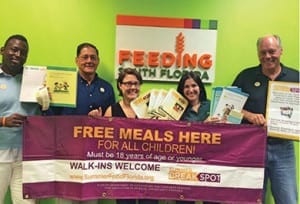
“We’re encouraging our partners to start serving meals to kids who may struggle over the summer,” said Paco Velez, president and CEO of Feeding South Florida.
As Summer BreakSpot sponsors, Feeding South Florida handles the administrative and financial oversight of the USDA program, which passes through a reimbursement for breakfasts, lunches and snacks that have all the components of nutritious meals at approved locations. Each lunch must include a serving of milk, two servings of fruits or vegetables, one grain and one protein.
At Summer BreakSpots children receive meals in a safe and supervised setting, which may include faith-based organizations, schools, parks, housing projects, day camps or community centers.
Children ages 18 and under who participate in the National School Lunch Program can benefit from these free meals offered while school is out. You can find locations all over South Florida that provide these free nutritious meals at www.summerfoodflorida.org.
The Meal Gap
According to a recently released study, Map The Meal Gap 2015, approximately 22.9 percent of children in South Florida are food insecure, leaving 280,630 children going to bed hungry. This is slightly higher than the national average, which is 21.4 percent.
The food gap is determined by calculating county-level data on food costs from The Nielsen Company to break down the food budget shortfall of residents into an approximation of the meals missing from the tables of people at risk of hunger.
“If these kids aren’t eating school meals, parents have to budget more,” said Velez, adding, “We’re trying to get these kids to live and thrive.”
Still, participation in this Summer Food Service Program is low. Of those who qualify for the program only 15.1 percent participate in Florida, which is slightly lower than the national average of 16.2 percent, Velez said.
There is still a need for community organizations to open SummerBreak Spot sites. “We’re trying to work with housing authorities and non-profits. For organizations, it’s a great way to help these kids who may struggle over the summer,” said Velez. “About 80 percent of our partners are faith based.”
How can you help?
How does an organization get involved? “They can either be a program sponsor and take care of their own meal preparation, or as a site all they have to do is let us know how many meals they need Monday through Friday and keep paperwork on the number of kids fed.”
It’s also important to determine if there are enough children in the area of the site who qualify for the program, and Velez said this can be determined by looking at the schools in the area. “If 50 percent of the people in the school qualify for free or reduced lunch, then you can be certain that a site nearby would qualify for the program,” he said.
To attract kids, many of the sites also offer enrichment programs and organized activities. Some require registration, such as summer camp programs, but others will allow children to just come in. And volunteers are always needed to distribute the food and supervise activities.
While participation in the Summer Food Service Program across the country has previously been as low 7 percent, Velez said states are doing a better job of promoting the program and we’re finding better ways to get the food out to the kids.
One of these creative solutions is renovating school buses in order to transport summer meals to neighborhood children in need. According to the USDA blog, “Orange County Public Schools’ mobile fleet includes a renovated school bus, food truck, catering van and two hot and cold trucks to serve students and their communities. The five mobile units together visit over 10 sites per day, making stops to mostly parks and recreation centers.”
Velez said he would like to spur on that kind of innovation in South Florida. “How many food trucks can we get on the road?” he asked.
To get involved, go to the web and look for volunteer opportunities to go and help hand out meals, make a financial contribution, open a site or put a bus into use that is going unused during the summer.
For more information, visit feedingsouthflorida.org or contact Michele Harvey, program manager, at [email protected].

Comments